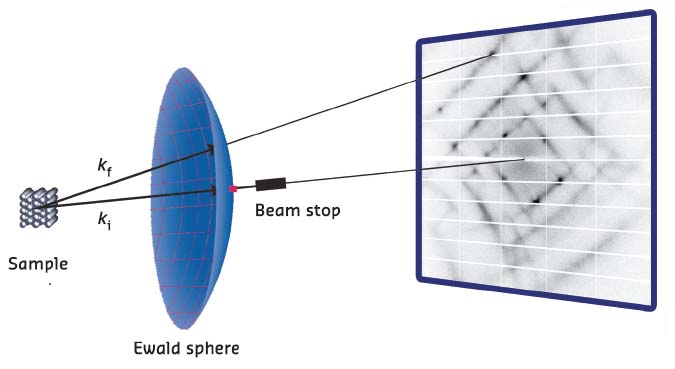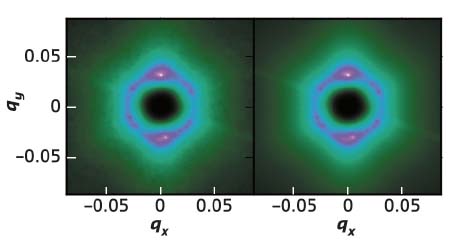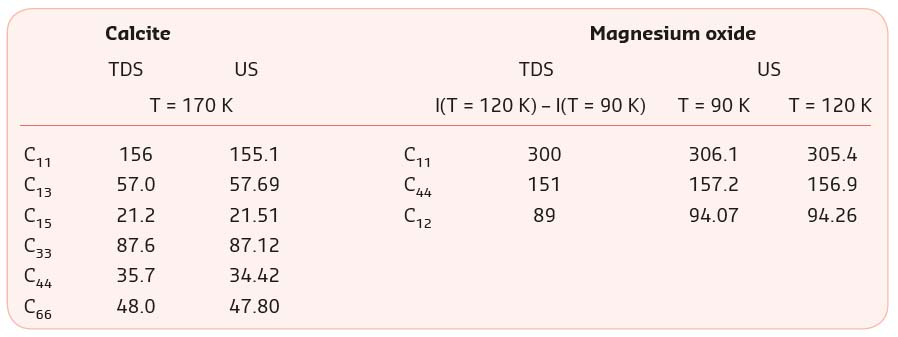- Home
- Users & Science
- Scientific Documentation
- ESRF Highlights
- ESRF Highlights 2017
- Electronic structure, magnetism and dynamics
- Elastic properties revealed by thermal diffuse scattering
Elastic properties revealed by thermal diffuse scattering
The full elasticity tensor can be obtained in a single crystal diffraction experiment through measurement of thermal diffuse scattering. Both the elastic properties and the crystal structure are determined by this new approach.
Elastic moduli give important insights into the mechanical behaviour of crystalline materials. Accurate measurements of the elasticity tensor – which contains the full set of elastic moduli – are of principal interest in materials science, geophysics and condensed matter physics. Applications include superconductors, low dimensional spin systems and an improved understanding of seismological wave propagation, which, in turn, allows for decisive conclusions on composition, temperature and pressure of the Earth’s interior.
The two most commonly used experimental techniques to determine the elastic tensor are ultrasound measurements and Brillouin scattering. While the former has strong limitations on small crystals and experiments under extreme conditions, the latter is difficult for opaque materials. Alternatively, information on the elasticity tensor can be obtained from inelastic scattering experiments. Now, it has been shown that the full elasticity tensor can be determined by high-precision measurements of thermal diffuse scattering from a single crystal, thus opening new perspectives in a range of scientific fields.
Thermal diffuse scattering arises from the vibrations of atoms around their equilibrium positions. In a scattering experiment these vibrations result in intensities in between Bragg reflections and are the fingerprints of the lattice dynamics. In the vicinity of Bragg reflections, the scattering intensities are dominated by acoustic phonons that correspond to elastic waves. These waves propagate with the speed of sound that can take different values depending on the composition, the crystal symmetry, direction and external influences such as temperature and pressure. The full information is given by the elasticity tensor, which can be extracted by a careful analysis of the scattering intensities.
High-quality single crystals of magnesium oxide and calcite are investigated as benchmark systems. The experimental setup is illustrated in Figure 91. Scattering intensities were collected at beamlines ID29 and BM01A. The sample was rotated with angular steps of 0.1° with exposure times adapted to the weak diffuse scattering. Measurements were taken at various temperatures. Details of the experimental setup and the underlying theory can be found elsewhere [1, 2].
 |
|
Fig. 91: Diffraction geometry for a diffuse scattering experiment in transmission [1]. The incoming monochromatic X-rays with wave vector ki are scattered by the sample and diffracted onto the Ewald sphere. The area detector records the planar projection of the Ewald sphere. |
The data treatment required a novel analysis technique and the development of a specialised software package, which comprises the precise reconstruction of reciprocal space and careful selection of regions in reciprocal space to be treated. The software simultaneously fits approximately 107 individual intensity points by taking into account the exact scattering geometry and symmetry of the crystal.
 |
|
Fig. 92: Measured (left panel) and calculated (right panel) thermal diffuse scattering from calcite (T = 170 K) for momentum transfers q ∈ [0.03, 0.15]. The images show a cross-section of the reciprocal space in Cartesian coordinates, in the neighbourhood of the Bragg peak [ |
Determination of the elastic moduli from thermal diffuse scattering measured at a single temperature is demonstrated for a small calcite single crystal. Experimental scattering intensities and calculated thermal diffuse scattering intensities from the fitted elastic moduli are compared in Figure 92. Remarkably, the results agree within about 1% with values determined by ultrasound measurements (see Table 1).
 |
|
Table 1: Elastic moduli of calcite and magnesium oxide determined from thermal diffuse scattering (TDS) and ultrasound measurements (US). Values are given in GPa. |
Absolute values of the elastic moduli can be obtained if measurements are taken at slightly different temperatures. This strategy further allows separation of the inelastic contribution from elastic scattering that may arise from disorder or imperfect surfaces. This is shown for magnesium oxide (see Table 1), for which accurate values in absolute units were obtained by fitting scattering intensities at two temperatures.
The new method is model-free and can be applied to very small and opaque crystals of arbitrary shape and symmetry. This implies a broad applicability in material science, geophysics and in the study of sound wave anomalies due to fundamental interactions in condensed matter physics. It is possible to measure the elastic properties together with the crystal structure in the same experiment. This is a great benefit for measurements at extreme conditions, such as high pressures, where it is often difficult to reproduce the exact experimental conditions.
Principal publication and authors
Full elasticity tensor from thermal diffuse scattering, B. Wehinger (a,b), A. Mirone (c), M. Krisch (c) and A. Bosak (c), Physical Review Letters 118, 035502 (2017); doi: 10.1103/PhysRevLett.118.035502.
(a) Department of Quantum Matter Physics, University of Geneva (Switzerland)
(b) Laboratory for Neutron Scattering and Imaging, Paul Scherrer Institute, Villigen (Switzerland)
(c) ESRF
References
[1] B. Wehinger, PhD thesis, Université de Grenoble (2013), http://tel.archives-ouvertes.fr/tel-00961602.
[2] A. Bosak et al., Journal of Physics. D, Applied Physics 48(50), 50400 (2015).
 , 0,
, 0,  ] with qz = 0. The scattering intensity is shown on a linear colour scale from black (zero) to white (maximum intensity).
] with qz = 0. The scattering intensity is shown on a linear colour scale from black (zero) to white (maximum intensity).


